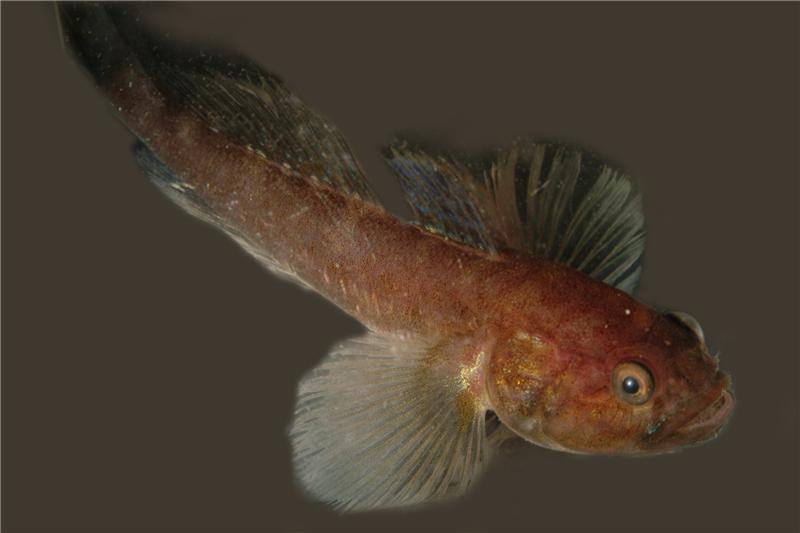This little goby-fish (Sufflogobius bibarbatus) reaches a maximum length of 13 cm and is only found in the Benguela ecosystem, the anoxic continental shelf outside Namibia and South-Africa, and one of the world’s most productive fisheries areas. Since the collapse of the sardine fisheries, this goby has become the new predominant prey species for larger fish, birds and mammals in the region.
Scientists from Norway, South Africa and Namibia have discovered how this little survivor copes in an environment that kills other fish and they say the findings could alter the way we now consider the structure and functioning of marine food-webs. Previously the belief was that fish could not survive in an environment of sulphide rich mud or between stinging jellyfish. But the bearded goby has become tolerant to these extreme environments.
How? During the day the goby stays on the anoxic seabed. Here it seems to 'hold its breath' while eating the mud and associated small organisms. Later, under cover of darkness, the goby swims up to the more oxygen rich surface waters in order to restore its oxygen and to digest its food, says senior scientist Anne Christine Utne-Palm from the University of Bergen.
While holding its breath it feasts on the sulphidic mud. It also thrives among jelly.

This goby is only found in the Benguela ecosystem, one of the world’s most productive fisheries area. The little goby-fish (Sufflogobius bibarbatus) reaches a maximum length of 13 cm. This goby also thrives among jelly. Photo: Hege Vestheim
"When gobies swim up to shallower waters at night, they associate with jellyfish. This is a night-time shelter from predators. Our studies in aquaria showed that goby predators avoid jellyfish, but that gobies are largely indifferent to them staying close and even swimming inbetween their stinging tentacles," says professor Anne Gro Vea Salvanes, co-author of the report in Science.
In the Benguela ecosystem off Namibia, an extreme environment is generated by natural processes; excess phytoplankton, and those not eaten by zooplankton accumulate on the bottom and over time build up to a thick rotting mud layer. This means that:
o Approximately 9 000 km2 of the continental shelf lacks oxygen
o Of this 7 000 km2 are covered in a mud that is rich in hydrogen sulphide (H2S) and sulphur bacteria. (H2S is the toxic gas that smells like rotten eggs and is poisonous)
o Methane gas and hydrogen sulphide build up in the sediment, causing frequent gas eruptions striping the entire water-column for oxygen, leading to massive mortality of fish and shellfish in the area.
The discoveries are that the goby has unique behavioral and physiological adaptations to the hostile Benguela environment. The physiological adaptation is that the goby suspends its breathing when oxygen is low. Experiments show that goby hearts recovers after anoxia, while hearts of its predator (hake) do not recover. Its ability to hold its breath helps the goby coping in with poisonous levels of H2S.The behavioral adaptation is what we call diurnal vertical migration (DVM), and the goby combines this with its feeding behavior and digestion of meals: it stays on the sea bed during day and moves up in the water column at night.
o Experiments in aquaria found that the goby preferred H2S-sediments over alternative sediment such as sand. The H2S-sediments kill goby predators. The goby capitalises on its advantage to shelter there from predatory fish and at the same time it feeds on the nutritious mud.
o While on the inhospitable seabed, however, the goby builds up an oxygen debt and so it has to move up into the water column to both refresh the blood and to digest its food. It does this at night, when predatory fish see less well.
o Up in the water at night the gobies appear to feed on jellyfish, whilst on the seabed they consume the mud and prey available there. Stable-isotope ratios in the tissue of gobies and their potential prey reveal that gobies consume considerable quantities of jellyfish, as well as the sulphide rich mud.
o The choice of associating with jellyfish whilst up in the water column represents the night-time shelter for the gobies. Experiments in aquaria show quite clearly that goby predators avoid jellyfish, but that gobies are indifferent to them and interact with the jellyfish’s stinging tentacles.
The findings are a result of accumulated knowledge achieved during a long-term research collaboration between Utne-Palm and Professor Anne Gro Vea Salvanes, University of Bergen, Professor Mark Gibbons, University of the Western Cape, South-Africa and Chief biologist Bronwen Currie, National Marine Information and Research Centre (NatMIRC), Namibia. The results presented in Science are achievements from interdisciplinary research conducted during several research cruises in the Benguela ecosystem off Namibia using the RV Dr. Fridtjof Nansen and the RV G.O. Sars.
Citation: Anne C. Utne-Palm, Anne G. V. Salvanes, Bronwen Currie, Stein Kaartvedt, Göran E. Nilsson, Victoria A. Braithwaite, Jonathan A. W. Stecyk, Matthias Hundt, Megan van der Bank, Bradley Flynn, Guro K. Sandvik, Thor A. Klevjer, Andrew K. Sweetman, Volker Brüchert, Karin Pittman, Kathleen R. Peard, Ida G. Lunde, Rønnaug A. U. Strandabø, Mark J. Gibbons, 'Trophic Structure and Community Stability in an Overfished Ecosystem',Science 16 July 2010:Vol. 329. no. 5989, pp. 333 - 336 DOI: 10.1126/science.1190708






Comments